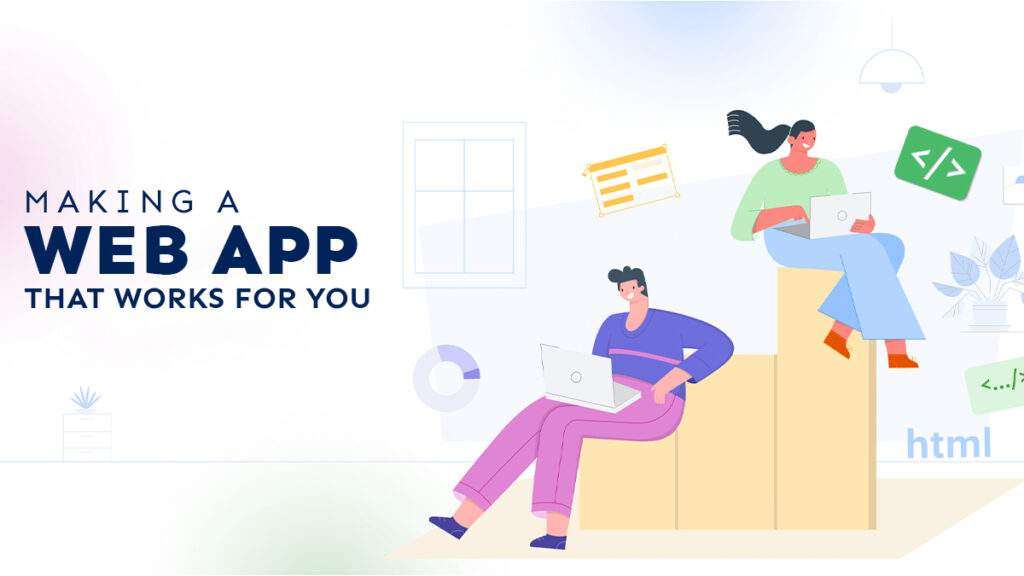
You have a unique web app idea and now you want to turn into a successful digital product. Superb!
But you don’t know how to make it possible. Right?
Stay connected with us for a few minutes. In this article, we will try to answer your maximum questions regarding the Web app development process.
We will also uncover the amazing benefits of website applications and guide you through the process step by step.
But before we dive straight into the details, let’s understand the basics of website application.
What is a web app?
A web app (or website application) is a type of software application. Users can run the web apps only via the web browser. It is totally different from traditional apps that require installation. A web app has nothing to do with such installations; you can run it in a browser.
The best example of a web app is Google Docs.
You can also build a multi-channel app having multiple target platforms, such as laptops, mobile phones, smartphones, or desktop computers. These types of apps are known for providing a seamless and interactive user experience.
Difference between web apps and websites
Both web apps and websites have different capabilities and benefits. Look at the following table; it will help you understand how a web app is different from a website!
| Web Apps | Websites | |
| Functionality | Offer interactive features and tasks | Primarily provide information and content |
| Interactivity | Enable user input and engagement | Limited user interaction beyond navigation |
| Dynamic Content | Display real-time or dynamic data | Often present static content |
| Task-Oriented | Designed for specific tasks or actions | Focus on presenting information or services |
| Usage Experience | Provide task-driven, personalized exp | Offer a more general browsing experience |
| Complexity | Can range from simple to complex apps | Generally simpler in terms of functionality |
| Updates | Can update dynamically without reinstall | Updates are usually manual and periodic |
| Installation | Accessed via browser, no installation | May require downloading/installing software |
| Cross-Platform | Compatible across devices/OSes via browser | OS-specific native apps are common |
| Development Approach | Requires programming for interaction | More focused on design and content creation |
Types of web applications
Web apps come in various flavors. Every type has unique needs as well as advantages. Let’s have a brief look at the common types of web apps:
E-commerce web apps: E-commerce web apps support shopping based on browsers. It manages the databases for orders, payments, and inventory. Most e-commerce businesses, including giants like Amazon, use web apps and mobile apps for shopping.
Social media web apps: Web applications include social networking platforms that you access through your web browser. The famous social media apps are Instagram, Facebook, LinkedIn, Twitter, etc.
Progressive web apps: A progressive web app is a website that not only looks like a mobile app but also functions like it. You can use both Mobile app development and web app development to create progressive web applications.
Entertainment web apps: Entertainment platforms like online gaming, multimedia sharing, etc. use entertainment web apps. Users can get a dose of pleasure from these apps without downloading them.
Educational web apps: The global education industry is changing as a result of educational online apps. It enables online classes, interactive learning, and distant learning.
Benefits of web apps over mobile apps
Now you know what a web application is and how it is different from websites and mobile applications. According to a study, almost 90% of mobile users spend most of their time on applications, but there are only a few apps that monopolize this attention.
This clearly shows how tough the competition is in mobile applications. It is the reason most businesses hesitate to make their business applications.
However, there’s a ray of hope in the form of web applications. Look at amazing benefits!
- Its cross-platform compatibility ensures a broader reach.
- No installation hassles; you can access these apps without downloading them.
- Web apps are more budget-friendly as compared to mobile apps.
- Web apps offer seamless and automatic update options.
- Web apps are more SEO-friendly, and attract more traffic.
Build your web application in 10 easy steps
Creating a web app might sound like a daunting task, but we’ve broken it down into 10 easy-to-follow steps that will have you well on your way to digital success:
Idea generation: The first step in making a web app is understanding an idea. Try to find out what problem your target audience faces, as every app idea starts with a realistic solution to an issue your potential users face.
Market research: The second step is understanding your target audience and your potential competitors. Give maximum time to this step, as market research, if properly done, can take your idea to the next level.
Wireframing and design: The third step is creating wireframes (or simply mock-ups) of the interface of your application. You know that design is one of the important things that increases user experience and automates the development process.
Choose the right technology: Now, you need to choose programming languages, their frameworks, and the necessary tools according to the app’s requirements. The development speed and scalability of your unique ideas depend on the Technology you choose.
Backend development: Create the server side of your application, which will manage business logic, data processing, and user authentication, much more. A strong backend guarantees the smooth running of web apps.
Frontend development: After backend development, you need to develop the user interface of your website application. You must be very creative and responsive with this development, as it will make your apps work seamlessly on different platforms.
Integrate features: The next step in the making of a web app is adding important features like search capabilities, user accounts, and interactive elements.
Testing: After you integrate features, perform a testing process to find out and fix bugs or errors. You will only be able to provide a seamless user experience when you have a bug-free app.
Deployment: Now, host your web app on a cloud platform or a reliable server. Your app should be accessible to your target users, and this is only possible if it has gone through a smooth deployment process.
Continuous improvement: Improvement process never ends. So, keep collecting feedback from your customers. It will help you improve your website application with time.
Final Remarks
We hope this article on how to make a web app will help you in your web app development process. Always select the right tools, execute the right processes with no shortcuts, and understand all the potential problems before you begin web app development.
Otherwise, your hard work will give you nothing in return.
Well, if you want our help, let us know now. We have the best and brightest web app developers on our team who will leave no stone unturned to convert your unique idea into a successful product.


